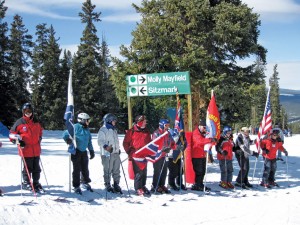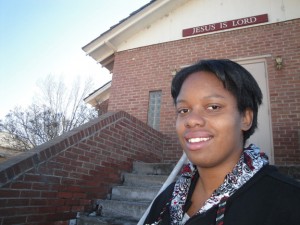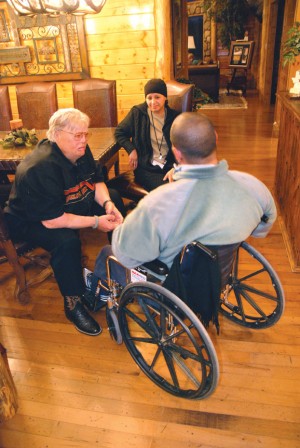By Laurel McHargue
Mainly because Nick, my eldest son and ROTC cadet, encouraged me to do it, I signed up – and actually did some training – for my first full marathon. In the summer of 2010 I completed two half marathons with no training, and that didn’t kill me. The idea of doing two in a row, however, made me think twice about the physical impact on my 52-year-old bones and so … grudgingly … I started “doing time” late December on a treadmill at our local gym. The race: The Bataan Memorial Death March Marathon in White Sands, New Mexico, March 27th, 2011.
“You pick a race with ‘Death’ in the title as your first marathon?” a friend chided me. The reason it was easy for me to say yes to this particular event was because of the actual Bataan Death March it commemorated. After reading about what the survivors of that tragic time experienced, I knew there would be no way that I could complain about a single step.
With our youngest son Jake, two great friends, and a truck full of gear we hit the road. Nothing but beautiful skies and gusty winds ahead … which within an hour from home became tornado strength, and showed no sign of easing at our destination. “It’ll die down as soon as the sun sets,” my husband Mike threw out. We all hoped he would be right. We surveyed our parking lot campground: campers struggling everywhere to secure tents, dust filled gusts which blurred our vision and left grit in our mouths, a setting sun and no sign of reprieve from the growing winds. It was fitting that we should have to experience some suffering before the Death March.
“There’s no way this can continue all night,” I said with conviction. In the tent now with Mike and Nick and a few 50 pound weights (Jake decided to sleep in the back seat of the truck), we tried to sleep as our dome tent shook, every zipper rattling, and threatened to fall in upon us. Ten o’clock. Eleven. Midnight. We began to giggle. We could hear vague grumblings from our friends in their sleeker tent, and knew that we were not the only sleepless ones. I had visions of lifting off the ground and landing in Munchkin Land. One o’clock and I had to pee.
I stumbled out of the tent and made my way across the street to a porta-potty … and nearly ended my chances of making it to the starting line six hours later. With hair in my eyes and sand-filled mules on my feet, the unexpected dip in the road along the curb took me down – hard. My knee slammed onto something sharp, and the force of my hands on the gravel kept me from breaking my nose on the edge of the curb. I got up with difficulty, and although I knew my knee was gushing, my fear was that I had broken my thumb.
Mike and Nick – incredulous that I had done so much damage in so little time – fixed me up with Band-Aids and Motrin, and by three a.m. we were giggling again, the wind – remarkably – was continuing to grow in force. For the next two hours I tried – in vain – to get comfortable; the five a.m. reveille bugle was a joy to hear over the sound of the slapping tent. By six, I stood outside with hundreds of other groggy, sleep-deprived race participants, and knew that I had had the proper prelude to the race which was about to begin. Bloody but not broken, I dressed and walked to the opening ceremonies with my punchy friends and family. Only Jake, who was there to support us, had slept the previous night.
The ceremony reminded us – the more than 6,000 runners in attendance – why we were there. When the first wave of runners passed by, I was immediately humbled. Among them were many of the Wounded Warriors, single and multiple amputees with prosthetic devices, who were running this race to honor the victims and survivors of Bataan.
The first half marathon was rather enjoyable; after all, I had trained for that much. Despite the lack of sleep and the driving winds which hindered uphill movement, I managed to maintain a steady pace and even enjoyed some chats with fellow runners. After a particularly long uphill stretch, I turned to see who owned the shadow at my back; I had noticed the shadow following my steps up the sandy, gusty incline, and was irritated that I was the only one blocking the wind. But the shadow was cast by a woman older than I who immediately apologized and then thanked me profusely. “You inspired me to keep going,” she confessed. I felt a little guilty that I had a secret training weapon; living at 10,200 feet and running at less than half that altitude made it extraordinarily easy to breathe under exertion. Life in Leadville was paying off.
With Gatorade in my Camelback and GU in my pocket, I had more than enough fuel to keep me moving, but by mile 17 I knew that my three months of treadmill training time had “run out.” The winds which earlier slowed me down now pushed too forcefully at my back on the downhill sections, and although I would like to have opened my stride and run like a gazelle, I felt more like an arthritic gorilla. Nevertheless, I would make it to the finish line. If I needed to, I would walk. Bataan survivors marched for days in sweltering conditions with neither food nor water.
With just 5K remaining, I caught up with a college girl who was also completing her first marathon, and we were both ready to walk. When we came to the 25-mile marker, I suggested that we consider running for the last 1.2 miles. “Do you want to?” she questioned, seeming to need my encouragement to do such an outrageous thing at this point. I looked ahead to an endless trail of stragglers and sand … so much sand … and said, “Let’s do it.” Together we matched step for step and completed the longest mile I have ever run, and crossed the finish line waving our little American flags in the endlessly blowing wind to the applause of countless supporters in just under six hours.
Thousands lost their lives back in the Philippines in 1942, and those who survived the torturous 70 mile forced march have lived with the physical and mental scars of the atrocities they endured. For me, this marathon was a box I could check … another proof to myself that I could do more than I wanted to do. No stabbing bayonets to move me along, no abuse, only words of encouragement from spectators and volunteers, plentiful aide stations along the way, new soldiers and old soldiers running in groups to keep me motivated. No one made me do it. I did not truly suffer.
Some info for this year’s race, and many more details can be found at www.bataanmarch.com/r09/reg.htm
Readers might consider a donation to either of these organizations.
The Wounded Warrior Project: www.woundedwarriorproject.org
First Descents Organization: firstdescents.org
After teaching at Lake County High School for the past four years, Laurel McHargue am now taking time off to write her first non-fiction book between jogs and countless other distractions that come with living in the most spectacular location on earth. Her blog is www.leadvillelaurel.com



